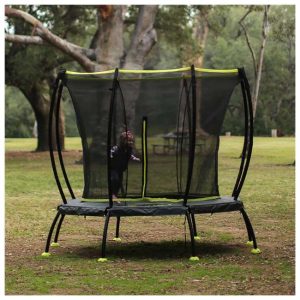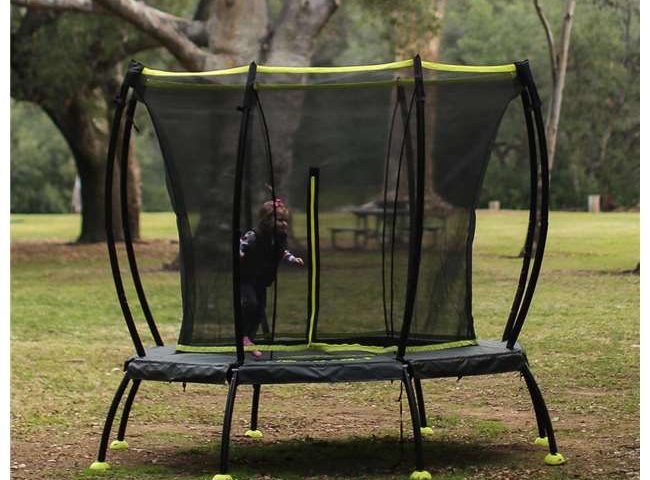
Dealing with Dyslexia
June 12, 2019Spelling Bees Challenge for Vocabulary Bloom
June 14, 2019BENEFITS OF THE TRAMPOLINE FOR HYPERACTIVE KIDS
There’s no doubt that kids love to bounce and trampolines are among the favourite (outdoor toys kids want). Special needs children are no different – fun is fun, regardless of your ability or skills.
Special needs is a broad brushed generalization that encompasses physical as well as mental limitations. Whether the condition is autism, reduced vision, physical limitations or learning challenges, spending time on a trampoline can positively impact your child in many ways.
People with autism spectrum disorders often suffer from anxiety and built-up stress. Some kids with autism will often jump up and down to relieve themselves from the tension. If this is done in the street or in a room full of furniture, it can lead to injuries. Jumping on a trampoline is a safe way to help people with ADHD or ASD to unwind after a busy day. A trampoline is a device consisting of a piece of taut, strong fabric stretched between a steel frame using many coiled springs. People bounce on trampolines for recreational and competitive purposes.
Children and grown-ups with an ASD have to deal with sensory imbalances and in order to control that feeling, they will seek relief in repetitive movements, like rocking, swinging fidgeting and jumping. Jumping on a trampoline is an excellent way to simulate these soothing moves and works as an anti-stress method at the same time. Once children with imbalances start using the trampoline, their previous sensory cravings can reduce. This is particularly beneficial for children who cave in destructive behaviours to use their excessive energy.
Many special needs children are somewhat sedentary while others have way too much energy. Both these categories of children can benefit through trampoline jumping. For the sedentary child, bouncing is a good form of exercise that exercises and strengthens all the body’s muscles as well as burns calories and improves coordination. Increased mobility can give a child more energy and help with general health such as aerobic and circulatory stimulation
One of the best things about owning a trampoline is that your kids can play at home. If you just want a fun play, you don’t have to head out to the park, go to a play centre, or do a paid activity. It’s not only convenient but it also means that, when you have older kids, you can be getting on with things around the house while they are occupied. It is also the ultimate alternative to spending weekends, afternoons and holidays in front of the TV or other screens for many kids. There are tons of games you can create that involve the trampoline – like adding some balloons or a sprinkler – on those days when the kids need more than a simple bounce.
What’s more, getting exposure to sunlight while playing outdoors raises kids’ levels of Vitamin D, which helps protect children from future bone problems. According to the Vitamin D Council, it also helps to improve the immune system, muscle function, cardiovascular function, the respiratory system and brain development, and even has anti-cancer benefits!
Bouncing or rebounding is great fun, and it’s also great exercise. In fact, ten minutes of jumping has been found to be about the same amount of exercise as thirty minutes of running! So it’s not only a great way to get fit and healthy, but it’s also a very efficient means of increasing fitness. Keeping fit and healthy through trampolining is additionally a fun way for kids to maintain a healthy weight and helps prevent issues such as childhood obesity.
Trampoline help strengthening the muscles around kids’ joints, trampolining also helps to strengthen the muscles around their spine. It also increases their core strength. Combined, both of these benefits are key to improving their posture.
As children suffering from ASD and ADHD often have behavioural and impulse control problems, as well as coordination issues. Regular trampoline exercise can help them deal with these challenges effectively, by helping them control their body movement and balance both physically and mentally. From the research conducted by our occupational therapist at Helping Hands Special School, concluded that when trampoline exercise becomes part of the daily routine:
√ Kids show signs of improvement in both their motor skills and interaction with other children.
√ If a family has a special needs kid and the other children find it hard to enjoy their company, the trampoline can be a great way for all of them to spend time together and play under serious monitoring
√ As trampoline requires the users to focus in order not to fall, it helps kids with ADHD gain clarity attention span, this way communication between the family members becomes easier and more effective
The benefits from this low impact “play” are that it exercises the whole body to improve muscle tone and flexibility while also improving joint function. Trampolines can be a great tool to help children with ASD to have a more balanced life.
Here’s the thing with trampolines. Kids get pitched into the air and then free fall. If they land on their feet in the center of the trampoline mat, great. But they can also land on the metal springs, on the hard frame, or on the ground. They can land on their arms, their ankles, their heads, and on other kids.
But what’s the likelihood that your kid is going to get hurt? That’s a lot harder to figure out. For one thing, we don’t have good data on how many kids jump on trampolines and how frequently, which is crucial to answering the question
CAUTION
• For home trampolines, install a trampoline enclosure — a special net designed to surround the trampoline — and cover the trampoline’s frame, springs and surrounding landing surfaces with protective pads. Regularly check the equipment for tears, detachments and deterioration.
• Place home trampolines at ground level. A fall from a higher surface increases the risk of injury. Make sure the trampoline is set a safe distance from trees and other hazards.
• Limit trampoline activity. Don’t allow a child younger than age 6 years to use the trampoline. Allow only one person to use the trampoline at a time. Don’t allow somersaults or other potentially risky moves on the trampoline without supervision and instruction.
• Don’t allow unsupervised jumping. If you use a trampoline ladder, always remove it after use to prevent unsupervised access by children and in addition, check to see if your insurance provider covers trampoline-related claims.nike shox mens australia women soccer players – White – DA8301 – 101 – Nike Air Force 1 ’07 LX Women’s Shoe | SBD – 100 Release Date – nike lebron ambassador 7 360 2017 edition appraise Tech Grey CT8527 – nike lunar woven chukka rainbow color wheel drive

